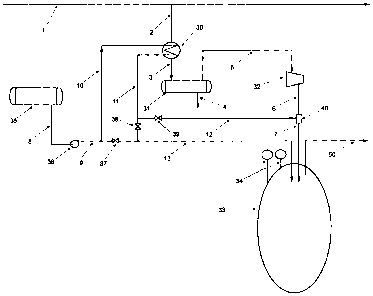Some of the information on this Web page has been provided by external sources. The Government of Canada is not responsible for the accuracy, reliability or currency of the information supplied by external sources. Users wishing to rely upon this information should consult directly with the source of the information. Content provided by external sources is not subject to official languages, privacy and accessibility requirements.
Any discrepancies in the text and image of the Claims and Abstract are due to differing posting times. Text of the Claims and Abstract are posted:
| (12) Patent: | (11) CA 2638663 |
|---|---|
| (54) English Title: | METHOD TO INCREASE GAS MASS FLOW INJECTION RATES TO GAS STORAGE CAVERNS USING LNG |
| (54) French Title: | PROCEDE PERMETTANT D'AUGMENTER LE DEBIT D'INJECTION MASSIQUE DE GAZ APPLIQUE AUX CAVITES DE STOCKAGE DE GAZ AU MOYEN DE GAZ NATUREL LIQUEFIE |
| Status: | Granted and Issued |
| (51) International Patent Classification (IPC): |
|
|---|---|
| (72) Inventors : |
|
| (73) Owners : |
|
| (71) Applicants : |
|
| (74) Agent: | NATHAN V. WOODRUFFWOODRUFF, NATHAN V. |
| (74) Associate agent: | |
| (45) Issued: | 2015-01-13 |
| (22) Filed Date: | 2007-07-20 |
| (41) Open to Public Inspection: | 2009-01-20 |
| Examination requested: | 2012-05-23 |
| Availability of licence: | N/A |
| Dedicated to the Public: | N/A |
| (25) Language of filing: | English |
| Patent Cooperation Treaty (PCT): | No |
|---|
| (30) Application Priority Data: | None |
|---|
A method to increase gas mass flow loading rates to a gas storage cavern includes using liquid natural gas (LNG) to cool natural gas in a natural gas flow line upstream of a compressor used to compress gas for storage in to a gas storage cavern.
Une méthode permettant d'augmenter les débits d'injection massique de gaz appliqués aux cavités de stockage de gaz comprend l'utilisation du gaz naturel liquéfié (GNL) pour refroidir le gaz naturel dans un flux de conduite d'écoulement de gaz d'un compresseur utilisé pour comprimer le gaz en vue du stockage dans une cavité de stockage de gaz.
Note: Claims are shown in the official language in which they were submitted.
Note: Descriptions are shown in the official language in which they were submitted.

2024-08-01:As part of the Next Generation Patents (NGP) transition, the Canadian Patents Database (CPD) now contains a more detailed Event History, which replicates the Event Log of our new back-office solution.
Please note that "Inactive:" events refers to events no longer in use in our new back-office solution.
For a clearer understanding of the status of the application/patent presented on this page, the site Disclaimer , as well as the definitions for Patent , Event History , Maintenance Fee and Payment History should be consulted.
| Description | Date |
|---|---|
| Inactive: COVID 19 - Deadline extended | 2020-07-16 |
| Common Representative Appointed | 2019-10-30 |
| Common Representative Appointed | 2019-10-30 |
| Grant by Issuance | 2015-01-13 |
| Inactive: Cover page published | 2015-01-12 |
| Inactive: Final fee received | 2014-10-17 |
| Pre-grant | 2014-10-17 |
| Notice of Allowance is Issued | 2014-09-11 |
| Letter Sent | 2014-09-11 |
| Notice of Allowance is Issued | 2014-09-11 |
| Inactive: QS passed | 2014-08-27 |
| Inactive: Approved for allowance (AFA) | 2014-08-27 |
| Amendment Received - Voluntary Amendment | 2014-05-26 |
| Letter Sent | 2013-12-12 |
| Letter Sent | 2013-12-12 |
| Inactive: S.30(2) Rules - Examiner requisition | 2013-11-26 |
| Inactive: Report - No QC | 2013-11-18 |
| Amendment Received - Voluntary Amendment | 2013-10-08 |
| Inactive: S.30(2) Rules - Examiner requisition | 2013-04-10 |
| Letter Sent | 2012-05-30 |
| Request for Examination Requirements Determined Compliant | 2012-05-23 |
| All Requirements for Examination Determined Compliant | 2012-05-23 |
| Request for Examination Received | 2012-05-23 |
| Inactive: Office letter | 2011-05-16 |
| Inactive: Office letter | 2011-05-16 |
| Inactive: Cover page published | 2009-01-21 |
| Inactive: IPC assigned | 2009-01-20 |
| Application Published (Open to Public Inspection) | 2009-01-20 |
| Inactive: First IPC assigned | 2009-01-20 |
| Inactive: IPC assigned | 2009-01-20 |
| Inactive: IPC assigned | 2009-01-20 |
| Inactive: IPC assigned | 2009-01-12 |
| Inactive: IPC removed | 2009-01-12 |
| Inactive: IPC assigned | 2009-01-12 |
| Inactive: Filing certificate - No RFE (English) | 2008-10-02 |
| Filing Requirements Determined Compliant | 2008-10-02 |
| Application Received - Regular National | 2008-10-02 |
There is no abandonment history.
The last payment was received on 2014-06-24
Note : If the full payment has not been received on or before the date indicated, a further fee may be required which may be one of the following
Please refer to the CIPO Patent Fees web page to see all current fee amounts.
Note: Records showing the ownership history in alphabetical order.
| Current Owners on Record |
|---|
| 1304342 ALBERTA LTD. |
| 1304338 ALBERTA LTD. |
| Past Owners on Record |
|---|
| JOSE LOURENCO |
| MACKENZIE MILLAR |